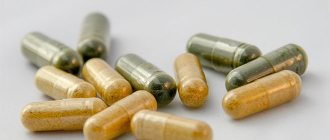Estradiol is one of the most powerful female sex hormones, produced by ovarian follicles and in small quantities by cells of the adrenal cortex. It is responsible for reproductive function, the development of sexual characteristics in women, the ability of an egg to fertilize, etc.
But these functions are performed only if there are no deviations from the norm. It often happens that the concentration of the hormone increases significantly, which negatively affects the female body. This is why it is so important to know the reasons for increased estradiol in women and the consequences to which this can lead.
About the properties of the hormone
Estradiol is an estrogen. It is responsible for secondary sexual characteristics. In women, it is produced in the ovaries and in small doses in the adrenal cortex. The hormone is responsible for reproductive function and femininity.
With elevated estradiol levels, the following is observed:
- High timbre of voice.
- Round breast shape.
- Normal blood cholesterol levels.
- Restful sleep.
- Regular menstruation.
Estradiol is important for the stable functioning of the entire body.
Recommendations
- Stick to proper nutrition . Limit consumption of fatty, sweet, fried, spicy foods and baked goods. Include in your diet as many fresh vegetables and fruits, herbs, whole grains, and bran as possible.
- It is recommended to engage in moderate physical activity : running, fitness, swimming, gymnastics, yoga, and be sure to monitor your weight.
- Completely eliminate bad habits from your life: alcoholic drinks, nicotine, drugs.
- Don't be nervous, avoid stress.
- Regularly undergo routine examination and diagnosis by an obstetrician-gynecologist.
- At the first symptoms (pain in the lower abdomen during menstruation, shortness of breath, swelling, tachycardia, acne, sleep disturbance, headaches, excessive sensitivity of the mammary glands), consult a specialist for a full examination and properly selected therapy.
Normal estradiol level
The normal value of this hormone changes in different phases of the menstrual cycle. Thus, in the follicular phase, the presence of estradiol in an amount of 90 to 600 pmol/l is considered normal. In the first phase - from 700 to 1400 pmol/l. In luteal - from 100 to 750 pmol/l. After 40 years, when menopause begins, the presence of the hormone in an amount of approximately 5 to 250 pmol/l is considered the norm.
This is what the test result for estradiol looks like. Pay attention to the reference (normal) values, they depend on the cycle.
It must be remembered that each laboratory calculates the amount of hormones in the body differently . To correctly interpret the analysis, you need to consult a gynecologist.
Estradiol during pregnancy
Estradiol levels begin to rise as a woman becomes pregnant. The indicator will increase until delivery. During pregnancy, the placenta is responsible for the production of estradiol in the body. The hormone helps the uterus develop, improves blood clotting and strengthens blood vessels.
Causes of elevated estradiol levels
A change in cycle phase is accompanied by a change in hormone levels
Estradiol (E2) is a steroid hormone and is the most active natural estrogen. In women, it affects the origin and development of the reproductive system, promotes the formation of secondary female characteristics, regulates the menstrual cycle and pregnancy, and affects the psycho-emotional state. In representatives of both sexes, it controls the functioning of the cardiovascular system and skeletal muscles, increases bone strength, participates in metabolism, and regulates the functioning of the gonads.
The level of E2 depends on the stage of the menstrual cycle (MC). During the maturation of the follicle, E2 is the dominant hormone secreted into the blood by the ovaries. Gradually its concentration increases, exceeding the initial value by 2-3 times by the ovulation phase. At the stage of release of a mature egg from the follicle, the concentration of E2 decreases, after which there is a subsequent peak in E2 levels in the middle of the luteal phase, that is, approximately on the 7th day after ovulation. If pregnancy does not occur, E2 production decreases, and after menstruation the cycle repeats. If conception has occurred, E2 levels rise until the end of the third trimester, returning to normal on the 4th day after birth.
E2 is also subject to daily fluctuations. Luteotropin, a hormone that affects reproductive function, maximally increases E2 levels between 15 and 18 hours, the minimum values occur from 12 to 2 am. In men, E2 concentration increases during puberty and also increases with obesity.
Liver pathology may affect hormone levels
The dependence of E2 on physiological fluctuations is taken into account by the doctor when studying its level. Hormone levels above normal indicate the following reasons:
- premature puberty in girls;
- delayed puberty in boys;
- estrogen-producing neoplasms of the ovaries, testicles, adrenal glands;
- persistence of a non-ovulated follicle;
- endometrioid ovarian cysts;
- choriocarcinoma;
- liver pathologies;
- gynecomastia (enlargement of the mammary glands in men);
- taking drugs that stimulate the processes of steroidogenesis, anabolic steroids, estrogen, antiepileptic drugs.
How to recognize the symptoms of the disease
An increase in estradiol in the body is considered normal only for pregnant women. If the indicator has increased significantly, but the girl is not carrying a child, it means that we are talking about some kind of disease.
There are several reasons for the increase in this sex hormone in women:
- ovarian tumors;
- liver diseases;
- obesity or sudden weight loss;
- sexual infections.
If a woman has elevated estradiol, the following symptoms may occur :
- Severe hair loss (alopecia) begins.
- Regular headache occurs.
- The menstrual cycle is disrupted.
- The breasts swell and are painful to touch.
- The appearance of fibroadenoma in the mammary glands.
- Constant emotional disturbances (sharp mood swings, as with PMS).
- Memory impairment (it can be difficult to remember something).
- Frequent insomnia.
- Chronic fatigue, even after a long rest.
In addition to these symptoms, women with elevated estradiol experience: restless sleep, fatigue and apathy, cold extremities at any time of the year. Also, for many, high levels of the hormone contribute to the appearance of skin diseases (for example, acne).
An increase in estradiol does not always indicate illness or pregnancy. When taking certain medications, the indicator may also increase!
Estradiol is low: what to do
Symptoms of a decrease in estradiol include weight loss, abnormal dry skin, and shrinkage of the mammary glands. An alarm signal may be the absence of menstruation for six cycles in a row without pregnancy. Some patients develop osteoporosis (reduction in the mass of bone tissue, disruption of their structure). Osteoporosis causes back pain.
Lack of estradiol can lead to anovulation (lack of ovulation). Pregnancy with this diagnosis is simply impossible, because the egg does not mature or leave the follicle.
The hormone level decreases when:
- anorexia nervosa (can develop against the background of amenorrhea);
- Shereshevsky-Turner syndrome (chromosomal abnormalities causing developmental abnormalities and sexual infantilism);
- Sheen's syndrome or hypopituitarism (low concentration of pituitary circulating hormones, which causes hypofunction, atrophy of the glands);
- Stein-Leventhal syndrome or polycystic ovary syndrome (dysfunction of the ovaries, hypothalamus and pituitary gland, pancreas and adrenal glands);
- hypogonadism (congenital underdevelopment, which leads to poor functioning of the ovaries);
- physical activity;
- postmenopause.
To prevent the development of all these diseases, you should respond to any ailment. Timely consultation with a doctor helps to avoid most dangerous consequences. Abnormalities can even be detected using a blood test.
Options for increasing estradiol levels:
- Hormonal therapy;
- Folk recipes (herbal infusions and decoctions). Sage, linden blossom, and hops are often used. Treatment with folk remedies should only be done on the recommendation of a herbalist.
- Following the rules of a healthy lifestyle.
- Complete cessation of smoking and alcohol.
- Walking outdoors and being active.
- Diet with proteins.
Any deviation from the norm requires study. A large decrease will not cause a serious deterioration in health, but will gradually depress the body.
What to do if a problem is detected
Elevated estradiol in women often indicates problems in the body. To prescribe effective treatment, the patient needs to undergo tests. A slight increase in estradiol can be cured using traditional medicine.
It is important to carefully prepare for the tests so that the result is as reliable as possible.
General rules for collecting blood from a vein:
- Blood is drawn on an empty stomach. Before some tests (for example, cholesterol levels or lipid profiles), you need to abstain from eating for a long time.
- The level of sex hormones is associated with secretion rhythms. This must be taken into account when drawing blood.
- The result of the analysis is influenced by the psycho-emotional and physical state of the patient. Sports activities are not recommended before donating blood. A minimum of a half-hour break is needed.
Preparation for the study must be correct.
Before going to the laboratory, you should not exert yourself physically and stop drinking alcohol and tobacco products. It’s also worth holding off on intimacy. The last meal should be 12 hours before taking a hormone test.
The best time to conduct a study on the amount of estradiol in the body is the morning of the fifth day of the cycle.
Signs and consequences of excess estradiol
Symptoms that estradiol is elevated in women may appear with varying intensity. It all depends on how strong the hormone surge is. Often this deviation is accompanied by:
- MC violations;
- the appearance of menstruation during menopause;
- a feeling of extreme fatigue that does not go away even after proper rest;
- sleep problems;
- sudden gain of several extra pounds;
- rapid fatigue;
- coldness of the upper and lower extremities.
In addition, the presence of the following abnormalities may indicate that estradiol is elevated in women:
- causeless irritability, mood swings;
- swelling of the limbs;
- acne that was not previously observed on the skin;
- breast pain, swelling;
- inability to conceive;
- increased dryness of the skin;
- hair loss;
- increased sweating.
Note. One of the signs of increased estradiol in women is a decrease in the reproductive organ. Such changes in the uterus are noted only during a gynecological examination - it is impossible to independently suspect and identify a deviation.
Elevated levels of estradiol in women are fraught with problems with the functioning of the gastrointestinal tract. In addition, this deviation is characterized by a noticeable decrease in the size of the mammary glands. These are not the most dangerous, but still unpleasant consequences of an excess of this hormone. To avoid more serious complications, you should consult a specialist immediately after the first alarming signs of high estradiol levels in women are noticed.
Treatment
If the hormone level is elevated, the doctor prescribes treatment based on the patient’s age. Therapy also depends on how much the indicator deviates from the norm. If the increase is small, then the woman needs to change her lifestyle to a more active one. It is also important to solve problems with the gastrointestinal tract. Sometimes following a certain diet is enough.
Some herbs help reduce estradiol in the body. Excess amounts of the hormone in the intestines can be removed by consuming fiber of plant origin (for example, wheat bran, cocoa, flax seeds).
Self-medication is unacceptable ! All nuances of therapy should be discussed with your doctor.
Prevention
You can avoid problems with estradiol by eliminating all “male” habits from your life: smoking, drinking alcoholic beverages, drug addiction, drug-induced tone enhancement. Most drugs to stimulate sexual function suppress the ovaries.
Leading an incorrect lifestyle, being carried away by bad habits and dubious sexual contacts, a woman actually ceases to be a woman. Estradiol, which makes girls sophisticated and soft, is reduced. As a result, abnormal growth of body hair begins, the voice becomes rougher, and the skin dries out.
conclusions
Estradiol is a hormonal substance that controls and supports particularly important processes throughout the body . It is necessary to maintain this type of hormone at a certain level, and if the clinical picture of the disease develops, certain measures should be taken. It is possible to maintain hormonal balance and prevent the occurrence of hormonal pathologies by following all of the above recommendations and advice from a specialist obstetrician-gynecologist.
source
Functional Features
The level of estradiol in women changes in accordance with the development of the follicle and in the postovulatory period. Estradiol is interdependent with the hormones of the anterior pituitary gland.
Estradiol in the first phase of the cycle is at a minimum level, and its maximum increase occurs in the luteal (middle) period. Serum estradiol levels rise from less than 50 pg/mL in the early follicular phase to 200–500 pg/mL mid-cycle, when estradiol is at its highest .
If the egg is not fertilized, the corpus luteum of menstruation is formed, which continues to produce estradiol for another 9 days. Then it regresses and dies. Estradiol drops to a minimum level and menstruation occurs.
When estradiol is elevated in the postovulatory phase, it indicates pregnancy. The hormone prepares the uterine lining for egg implantation. After the 12th week of pregnancy, the function of producing estradiol passes to the placenta . The normal limit is elevated throughout pregnancy and returns to the pre-pregnancy level within a week after birth.
Estradiol also affects:
- blood clotting factors;
- strength of skeletal bones;
- strength of the heart muscle;
- lipid balance;
- normal circadian rhythm.
After 40 years, a woman’s estradiol levels decrease until the onset of menopause. During menopause, the estradiol norm is 19.7–82 pg/ml. This leads to the decline of reproductive function and the development of osteoporosis.
Age norms
The concentration of sex hormones changes throughout life. Interestingly, until the age of 12-14 years, the level of E2 in girls and boys is approximately the same. It is only during puberty that the ovaries begin to secrete large amounts of estrogens. The reverse process occurs in the body of women 45-50 years old, when reproductive function gradually fades away. That is why it is important to correctly interpret the obtained estradiol values: the norm for women by age is presented in the table below.
| Age, years | E2: age norm | |
| pg/ml | pmol/l | |
| 0-6 | 0-22 | 0-155 |
| 7-14 | 22-57 | 42-355 |
| 15-55 | 57-227 | 68-1269 |
| >55 | 19-85 | 0-73 |
In addition, in women of reproductive age, E2 levels vary depending on the phase of the cycle.
We recommend reading: Hypothalamic hormones and their functions: table
| MC Day | Phase | Estradiol: norm in women 15-45 years old | |
| pg/ml | pmol/l | ||
| 1-14 | Follicular | 57-227 | 68-1269 |
| 15-16 | Ovulation | 127-427 | 131-1665 |
| 16-30 | Luteal | 77=227 | 91-861 |
In healthy men, the concentration of estradiol is more stable and remains almost unchanged throughout life. Reference values are presented in the table.
| Age, years | E2: normal for men | |
| pg/ml | pmol/l | |
| 0-1 | 0-54 | 0-86 |
| 1-10 | 0-20 | 0-69 |
| 11-18 | 0-86 | 0-182 |
| >18 | 7,63-42,6 | 40-161 |
What influences the result
There are several factors influencing the reliability of the results obtained. Thus, falsely elevated estradiol levels occur when:
- taking combined oral contraceptives (birth control pills);
- long-term treatment with glucocorticosteroids, penicillins, phenothiazines, cascara sagrada herb;
- use of anabolic steroids.
Intense physical activity, a vegetarian diet, and insufficient dietary fat intake, on the contrary, can lead to a decrease in estrogen levels in the body.
Complications may be
An imbalance in hormone levels (regardless of which direction it varies) is a phenomenon that is far from normal. Such disruptions in the female body are a serious threat.
The highest level of estradiol lasts a long time, which means that the result will be complications:
- depression;
- uterine bleeding;
- anemia;
- malignant tumors on the ovaries;
- infertility.
There is no need to wait for such serious consequences; you should consult a doctor who will conduct a diagnostic study and prescribe the necessary course of therapy.
Causes of high levels of female hormones
If estradiol is elevated, but this fact does not cause panic, it means that the woman is pregnant.
In all other cases, it is necessary to look for and then eliminate the cause. These include:
- cirrhosis of the liver or other diseases of this organ;
- excess weight or rapid weight loss;
- dysfunction of the thyroid gland;
- various tumors (adrenal glands, mammary glands);
- ovarian cysts;
- excessive consumption of alcoholic beverages;
- long-term use of medications (antifungal, hormonal).
What can lead to an increase
An increase in estradiol in a woman is observed during pregnancy. If there is no pregnancy, tests are ordered to determine the reasons for the increase. Factors that increase estradiol can be:
- incorrect use of birth control pills;
- rapid weight gain;
- tumors in the ovaries or breasts;
- liver or thyroid disease,
- chronic alcohol abuse and smoking.
We recommend reading: The chemistry of love is a disease, hormones, pheromones, scientific research, how long the reaction lasts
Primary causes
Hormone-synthesizing neoplasms of the ovaries are classified as primary. Some tumors are capable of synthesizing hormone-like substances similar to estradiol. Therefore, the patient’s test results reveal an increased value.
A similar situation is observed during the formation of an adrenal tumor.
Another reason for high estradiol levels in women is chorionepithelioma, a malignant tumor that grows in the form of a node in the upper part of the uterus. Such a formation is capable of synthesizing female sex hormones in excess quantities.
It is also possible to develop hyperestrogenism due to the persistence of follicles or the presence of endometrioid cysts.
Secondary causes of increased estradiol
Secondary causes include:
- incorrectly selected oral contraceptives, which led to hormonal imbalance;
- treatment with anabolic steroid drugs;
- treatment with carbamazepine, cimetidine, clomiphene, ketoconazole, mifepristone, nafarelin, etc.;
- presence of excess body weight. It is known that fat cells actively produce female sex hormones;
- hepatitis of viral etiology or cirrhosis of the liver. These pathologies contribute to cell destruction. What causes disruptions in the process of hormone metabolism. Against the background of insufficient removal of estradiol from the body, its value in the analysis results increases.
In girls, an increase in estradiol levels indicates the onset of puberty and the approach of menarche.











